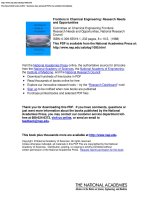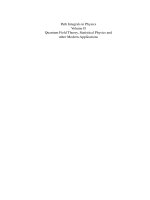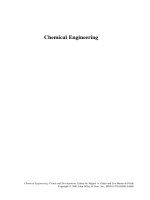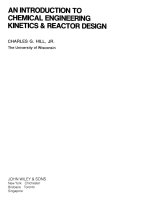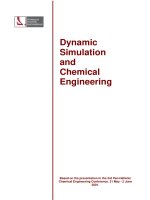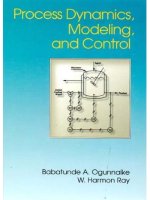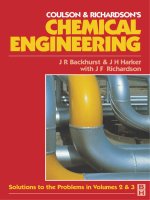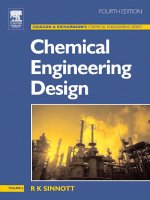coulson and richardson - chemical engineering vol. 2 particle technology and separation processes (5th ed)
Bạn đang xem bản rút gọn của tài liệu. Xem và tải ngay bản đầy đủ của tài liệu tại đây (13.68 MB, 1,209 trang )
Coulson and Richardson’s
CHEMICAL ENGINEERING
VOLUME 2
FIFTH EDITION
Particle Technology and
Separation Processes
Related Butterworth-Heinemann Titles in the Chemical Engineering Series by
J. M. COULSON & J. F. RICHARDSON
Chemical Engineering, Volume 1, Sixth edition
Fluid Flow, Heat Transfer and Mass Transfer
(withJ.R.BackhurstandJ.H.Harker)
Chemical Engineering, Volume 3, Third edition
Chemical and Biochemical Reaction Engineering, and Control
(edited by J. F. Richardson and D. G. Peacock)
Chemical Engineering, Volume 6, Third edition
Chemical Engineering Design
(R.K.Sinnott)
Chemical Engineering, Solutions to Problems in Volume 1
(J. R. Backhurst, J. H. Harker and J. F. Richardson)
Chemical Engineering, Solutions to Problems in Volume 2
(J. R. Backhurst, J. H. Harker and J. F. Richardson)
Coulson and Richardson’s
CHEMICAL ENGINEERING
VOLUME 2
FIFTH EDITION
Particle Technology and
Separation Processes
J. F. RICHARDSON
University of Wales Swansea
and
J. H. HARKER
University of Newcastle upon Tyne
with
J. R. BACKHURST
University of Newcastle upon Tyne
OXFORD AMSTERDAM BOSTON LONDON NEW YORK PARIS
SAN DIEGO SAN FRANCISCO SINGAPORE SYDNEY TOKYO
Butterworth-Heinemann
An imprint of Elsevier Science
Linacre House, Jordan Hill, Oxford OX2 8DP
225 Wildwood Avenue, Woburn, MA 01801-2041
First published 1955
Reprinted (with revisions) 1956, 1959, 1960
Reprinted 1962
Second edition 1968
Reprinted 1976
Third edition (SI units) 1978
Reprinted (with revisions) 1980, 1983, 1985, 1987, 1989
Fourth edition 1991
Reprinted (with revisions) 1993, 1996, 1997, 1998, 1999, 2001
Fifth edition 2002
Copyright
1991, 2002, J. F. Richardson and J. H. Harker. All rights reserved
The right of J. F. Richardson and J. H. Harker to be identified as the authors of this work has been asserted in
accordance with the Copyright, Designs and Patents Act 1988
All rights reserved. No part of this publication may be reproduced in
any material form (including photocopying or storing in any medium by
electronic means and whether or not transiently or incidentally to some
other use of this publication) without the written permission of the
copyright holder except in accordance with the provisions of the Copyright,
Designs and Patents Act 1988 or under the terms of a licence issued by the
Copyright Licensing Agency Ltd, 90 Tottenham Court Road, London,
England W1P 0LP. Applications for the copyright holder’s written
permission to reproduce any part of this publication should be addressed
to the publishers
British Library Cataloguing in Publication Data
A catalogue record for this book is available from the British Library
Library of Congress Cataloguing in Publication Data
A catalogue record for this book is available from the Library of Congress
ISBN 0 7506 4445 1
Typeset by Laserwords Private Limited, Chennai, India
Printed and bounded in Great Britain by the Bath Press, Bath
Preface to the Fifth Edition xvii
Preface to the Fourth Edition xix
Preface to the 1983 Reprint of the Third Edition xxi
Preface to Third Edition xxiii
Preface to Second Edition xxv
Preface to First Edition xxvii
Acknowledgements xxix
INTRODUCTION xxxi
1 Particulate Solids 1
1.1. INTRODUCTION 1
1.2. PARTICLE CHARACTERISATION 2
1.3. PARTICULATE SOLIDS IN BULK 22
1.4. BLENDING OF SOLID PARTICLES 30
1.5. CLASSIFICATION OF SOLID PARTICLES 37
1.6. SEPARATION OF SUSPENDED SOLID
PARTICLES FROM FLUIDS 67
1.7. FURTHER READING 91
1.8. REFERENCES 92
1.9. NOMENCLATURE 93
2 Particle Size Reduction and Enlargement 95
2.1. INTRODUCTION 95
2.2. SIZE REDUCTION OF SOLIDS 95
2.3. TYPES OF CRUSHING EQUIPMENT 106
2.4. SIZE ENLARGEMENT OF PARTICLES 137
2.5. FURTHER READING 143
2.6. REFERENCES 143
2.7. NOMENCLATURE 144
3 Motion of Particles in a Fluid 146
3.1. INTRODUCTION 146
3.2. FLOW PAST A CYLINDER AND A SPHERE 146
3.3. THE DRAG FORCE ON A SPHERICAL
PARTICLE 149
3.4. NON-SPHERICAL PARTICLES 164
3.5. MOTION OF BUBBLES AND DROPS 168
3.6. DRAG FORCES AND SETTLING VELOCITIES
FOR PARTICLES IN NON- NEWTONIAN FLUIDS 169
3.7. ACCELERATING MOTION OF A PARTICLE IN
THE GRAVITATIONAL FIELD 173
3.8. MOTION OF PARTICLES IN A CENTRIFUGAL
FIELD 185
3.9. FURTHER READING 187
3.10. REFERENCES 188
3.11. NOMENCLATURE 189
4 Flow of Fluids through Granular Beds and
Packed Columns 191
4.1. INTRODUCTION 191
4.2. FLOW OF A SINGLE FLUID THROUGH A
GRANULAR BED 191
4.3. DISPERSION 205
4.4. HEAT TRANSFER IN PACKED BEDS 211
4.5. PACKED COLUMNS 212
4.6. FURTHER READING 232
4.7. REFERENCES 232
4.8. NOMENCLATURE 234
5 Sedimentation 237
5.1. INTRODUCTION 237
5.2. SEDIMENTATION OF FINE PARTICLES 237
5.3. SEDIMENTATION OF COARSE PARTICLES 267
5.4. FURTHER READING 286
5.5. REFERENCES 286
5.6. NOMENCLATURE 288
6 Fluidisation 291
6.1. CHARACTERISTICS OF FLUIDISED
SYSTEMS 291
6.2. LIQUID-SOLIDS SYSTEMS 302
6.3. GAS-SOLIDS SYSTEMS 315
6.4. GAS-LIQUID SOLIDS FLUIDISED BEDS 333
6.5. HEAT TRANSFER TO A BOUNDARY
SURFACE 334
6.6. MASS AND HEAT TRANSFER BETWEEN
FLUID AND PARTICLES 343
6.7. SUMMARY OF THE PROPERTIES OF
FLUIDISED BEDS 357
6.8. APPLICATIONS OF THE FLUIDISED SOLIDS
TECHNIQUE 358
6.9. FURTHER READING 364
6.10. REFERENCES 364
6.11. NOMENCLATURE 369
7 Liquid Filtration 372
7.1. INTRODUCTION 372
7.2. FILTRATION THEORY 374
7.3. FILTRATION PRACTICE 382
7.4. FILTRATION EQUIPMENT 387
7.5. FURTHER READING 434
7.6. REFERENCES 435
7.7. NOMENCLATURE 435
8 Membrane Separation Processes 437
8.1. INTRODUCTION 437
8.2. CLASSIFICATION OF MEMBRANE
PROCESSES 437
8.3. THE NATURE OF SYNTHETIC MEMBRANES 438
8.4. GENERAL MEMBRANE EQUATION 442
8.5. CROSS-FLOW MICROFILTRATION 442
8.6. ULTRAFILTRATION 446
8.7. REVERSE OSMOSIS 452
8.8. MEMBRANE MODULES AND PLANT
CONFIGURATION 455
8.9. MEMBRANE FOULING 464
8.10. ELECTRODIALYSIS 465
8.11. REVERSE OSMOSIS WATER TREATMENT
PLANT 467
8.12. PERVAPORATION 469
8.13. LIQUID MEMBRANES 471
8.14. GAS SEPARATIONS 472
8.15. FURTHER READING 472
8.16. REFERENCES 473
8.17. NOMENCLATURE 474
9 Centrifugal Separations 475
9.1. INTRODUCTION 475
9.2. SHAPE OF THE FREE SURFACE OF THE
LIQUID 476
9.3. CENTRIFUGAL PRESSURE 477
9.4. SEPARATION OF IMMISCIBLE LIQUIDS OF
DIFFERENT DENSITIES 478
9.5. SEDIMENTATION IN A CENTRIFUGAL FIELD 480
9.6. FILTRATION IN A CENTRIFUGE 485
9.7. MECHANICAL DESIGN 489
9.8. CENTRIFUGAL EQUIPMENT 489
9.9. FURTHER READING 500
9.10. REFERENCES 500
9.11. NOMENCLATURE 501
10 Leaching 502
10.1. INTRODUCTION 502
10.2. MASS TRANSFER IN LEACHING
OPERATIONS 503
10.3. EQUIPMENT FOR LEACHING 506
10.4. COUNTERCURRENT WASHING OF SOLIDS 515
10.5. CALCULATION OF THE NUMBER OF
STAGES 519
10.6. NUMBER OF STAGES FOR
COUNTERCURRENT WASHING BY GRAPHICAL
METHODS 526
10.7. FURTHER READING 540
10.8. REFERENCES 540
10.9. NOMENCLATURE 540
11 Distillation 542
11.1. INTRODUCTION 542
11.2. VAPOUR LIQUID EQUILIBRIUM 542
11.3. METHODS OF DISTILLATION TWO
COMPONENT MIXTURES 555
11.4. THE FRACTIONATING COLUMN 559
11.5. CONDITIONS FOR VARYING OVERFLOW IN
NON-IDEAL BINARY SYSTEMS 581
11.6. BATCH DISTILLATION 592
11.7. MULTICOMPONENT MIXTURES 599
11.8. AZEOTROPIC AND EXTRACTIVE
DISTILLATION 616
11.9. STEAM DISTILLATION 621
11.10. PLATE COLUMNS 625
11.11. PACKED COLUMNS FOR DISTILLATION 638
11.12. FURTHER READING 649
11.13. REFERENCES 649
11.14. NOMENCLATURE 652
12 Absorption of Gases 656
12.1. INTRODUCTION 656
12.2. CONDITIONS OF EQUILIBRIUM BETWEEN
LIQUID AND GAS 657
12.3. THE MECHANISM OF ABSORPTION 658
12.4. DETERMINATION OF TRANSFER
COEFFICIENTS 666
12.5. ABSORPTION ASSOCIATED WITH
CHEMICAL REACTION 675
12.6. ABSORPTION ACCOMPANIED BY THE
LIBERATION OF HEAT 681
12.7. PACKED TOWERS FOR GAS ABSORPTION 682
12.8. PLATE TOWERS FOR GAS ABSORPTION 702
12.9. OTHER EQUIPMENT FOR GAS
ABSORPTION 709
12.10. FURTHER READING 714
12.11. REFERENCES 715
12.12. NOMENCLATURE 717
13 Liquid Liquid Extraction 721
13.1. INTRODUCTION 721
13.2. EXTRACTION PROCESSES 722
13.3. EQUILIBRIUM DATA 725
13.4. CALCULATION OF THE NUMBER OF
THEORETICAL STAGES 728
13.5. CLASSIFICATION OF EXTRACTION
EQUIPMENT 742
13.6. STAGE-WISE EQUIPMENT FOR
EXTRACTION 744
13.7. DIFFERENTIAL CONTACT EQUIPMENT FOR
EXTRACTION 750
13.8. USE OF SPECIALISED FLUIDS 763
13.9. FURTHER READING 766
13.10. REFERENCES 767
13.11. NOMENCLATURE 769
14 Evaporation 771
14.1. INTRODUCTION 771
14.2. HEAT TRANSFER IN EVAPORATORS 771
14.3. SINGLE-EFFECT EVAPORATORS 778
14.4. MULTIPLE-EFFECT EVAPORATORS 780
14.5. IMPROVED EFFICIENCY IN EVAPORATION 791
14.6. EVAPORATOR OPERATION 802
14.7. EQUIPMENT FOR EVAPORATION 805
14.8. FURTHER READING 823
14.9. REFERENCES 823
14.10. NOMENCLATURE 825
15 Crystallisation 827
15.1. INTRODUCTION 827
15.2. CRYSTALLISATION FUNDAMENTALS 828
15.3. CRYSTALLISATION FROM SOLUTIONS 853
15.4. CRYSTALLISATION FROM MELTS 868
15.5. CRYSTALLISATION FROM VAPOURS 875
15.6. FRACTIONAL CRYSTALLISATION 885
15.7. FREEZE CRYSTALLISATION 888
15.8. HIGH PRESSURE CRYSTALLISATION 890
15.9. FURTHER READING 893
15.10. REFERENCES 894
15.11. NOMENCLATURE 897
16 Drying 901
16.1. INTRODUCTION 901
16.2. GENERAL PRINCIPLES 901
16.3. RATE OF DRYING 904
16.4. THE MECHANISM OF MOISTURE
MOVEMENT DURING DRYING 912
16.5. DRYING EQUIPMENT 918
16.6. SPECIALISED DRYING METHODS 957
16.7. THE DRYING OF GASES 963
16.8. FURTHER READING 964
16.9. REFERENCES 965
16.10. NOMENCLATURE 967
17 Adsorption 970
17.1. INTRODUCTION 970
17.2. THE NATURE OF ADSORBENTS 974
17.3. ADSORPTION EQUILIBRIA 979
17.4. MULTICOMPONENT ADSORPTION 993
17.5. ADSORPTION FROM LIQUIDS 994
17.6. STRUCTURE OF ADSORBENTS 994
17.7. KINETIC EFFECTS 1002
17.8. ADSORPTION EQUIPMENT 1008
17.9. REGENERATION OF SPENT ADSORBENT 1026
17.10. FURTHER READING 1047
17.11. REFERENCES 1047
17.12. NOMENCLATURE 1049
18 Ion Exchange 1053
18.1. INTRODUCTION 1053
18.2. ION EXCHANGE RESINS 1054
18.3. RESIN CAPACITY 1054
18.4. EQUILIBRIUM 1056
18.5. EXCHANGE KINETICS 1060
18.6. ION EXCHANGE EQUIPMENT 1066
18.7. FURTHER READING 1073
18.8. REFERENCES 1073
18.9. NOMENCLATURE 1074
19 Chromatographic Separations 1076
19.1. INTRODUCTION 1076
19.2. ELUTION CHROMATOGRAPHY 1077
19.3. BAND BROADENING AND SEPARATION
EFFICIENCY 1080
19.4. TYPES OF CHROMATOGRAPHY 1083
19.5. LARGE SCALE ELUTION (CYCLIC BATCH)
CHROMATOGRAPHY 1088
19.6. SELECTIVE ADSORPTION OF PROTEINS 1093
19.7. SIMULATED COUNTERCURRENT
TECHNIQUES 1096
19.8. COMBINED REACTION AND SEPARATION 1098
19.9. COMPARISON WITH OTHER SEPARATION
METHODS 1099
19.10. FURTHER READING 1100
19.11. REFERENCES 1100
19.12. NOMENCLATURE 1103
20 Product Design and Process Intensification 1104
20.1. PRODUCT DESIGN 1104
20.2. PROCESS INTENSIFICATION 1110
20.3. FURTHER READING 1134
20.4. REFERENCES 1134
Appendix 1137
A1. STEAM TABLES 1138
A2. CONVERSION FACTORS FOR SOME
COMMON SI UNITS 1147
Problems 1149
Preface to the Fifth Edition
It is now 47 years since Volume 2 was first published in 1955, and during the inter-
vening time the profession of chemical engineering has grown to maturity in the UK, and
worldwide; the Institution of Chemical Engineers, for instance, has moved on from its 33rd
to its 80th year of existence. No longer are the heavy chemical and petroleum-based indus-
tries the main fields of industrial applications of the discipline, but chemical engineering
has now penetrated into areas, such as pharmaceuticals, health care, foodstuffs, and
biotechnology, where the general level of sophistication of the products is much greater,
and the scale of production often much smaller, though the unit value of the products is
generally much higher. This change has led to a move away from large-scale continuous
plants to smaller-scale batch processing, often in multipurpose plants. Furthermore, there
is an increased emphasis on product purity, and the need for more refined separation
technology, especially in the pharmaceutical industry where it is often necessary to carry
out the difficult separation of stereo-isomers, one of which may have the desired thera-
peutic properties while the other is extremely malignant. Many of these large molecules
are fragile and are liable to be broken down by the harsh solvents commonly used in
the manufacture of bulk chemicals. The general principles involved in processing these
more specialised materials are essentially the same as in bulk chemical manufacture, but
special care must often be taken to ensure that processing conditions are mild.
One big change over the years in the chemical and processing industries is the emphasis
on designing products with properties that are specified, often in precise detail, by the
customer. Chemical composition is often of relatively little importance provided that the
product has the desired attributes. Hence product design, a multidisciplinary activity, has
become a necessary precursor to process design.
Although undergraduate courses now generally take into account these new require-
ments, the basic principles of chemical engineering remain largely unchanged and this
is particularly the case with the two main topics of Volume 2, Particle Mechanics and
Separation Processes. In preparing this new edition, the authors have faced a typical
engineering situation where a compromise has to be reached on size. The knowledge-
base has increased to such an extent that many of the individual chapters appear to merit
expansion into separate books. At the same time, as far as students and those from other
disciplines are concerned, there is still a need for a an integrated concise treatment in
which there is a consistency of approach across the board and, most importantly, a degree
of uniformity in the use of symbols. It has to be remembered that the learning capacity
of students is certainly no greater than it was in the past, and a book of manageable
proportions is still needed.
The advice that academic staffs worldwide have given in relation to revising the book
has been that the layout should be retained substantially unchanged — better the devil
we know, with all his faults! With this in mind the basic structure has been maintained.
However, the old Chapter 8 on Gas Cleaning, which probably did not merit a chapter
xvii
xviii PREFACE TO THE FIFTH EDITION
on its own, has been incorporated into Chapter 1, where it sits comfortably beside other
topics involving the separation of solid particles from fluids. This has left Chapter 8 free
to accommodate Membrane Separations (formerly Chapter 20) which then follows on
logically from Filtration in Chapter 7. The new Chapter 20 then provides an opportunity
to look to the future, and to introduce the topics of Product Design and the Use of
Intensified Fields (particularly centrifugal in place of gravitational) and miniaturisation,
with all the advantages of reduced hold-up, leading to a reduction in the amount of
out-of-specification material produced during the changeover between products in the
case multipurpose plants, and in improved safety where the materials have potentially
hazardous properties.
Other significant changes are the replacement of the existing chapter on Crystallisation
by an entirely new chapter written with expert guidance from Professor J. W. Mullin, the
author of the standard textbook on that topic. The other chapters have all been updated and
additional Examples and Solutions incorporated in the text. Several additional Problems
have been added at the end, and solutions are available in the Solutions Manual, and now
on the Butterworth-Heinemann website.
We are, as usual, indebted to both reviewers and readers for their suggestions and for
pointing out errors in earlier editions. These have all been taken into account. Please keep
it up in future! We aim to be error-free but are not always as successful as we would like
to be! Unfortunately, the new edition is somewhat longer than the previous one, almost
inevitably so with the great expansion in the amount of information available. Whenever
in the past we have cut out material which we have regarded as being out-of-date, there is
inevitably somebody who writes to say that he now has to keep both the old and the new
editions because he finds that something which he had always found particularly useful
in the past no longer appears in the revised edition. It seems that you cannot win, but we
keep trying!
J. F. R
ICHARDSON
J. H. HARKER
Preface to the Fourth Edition
Details of the current restructuring of this Chemical Engineering Series, coinciding with
the publication of the Fourth Edition of Volumes 1 and 2 and to be followed by new
editions of the other volumes, have been set out in the Preface to the Fourth Edition of
Volume 1. The revision involves the inclusion in Volume 1 of material on non-Newtonian
flow (previously in Volume 3) and the transference from Volume 2 to Volume 1 of
Pneumatic and Hydraulic Conveying and Liquid Mixing. In addition, Volume 6, written by
Mr. R. K. Sinnott, which first appeared in 1983, nearly thirty years after the first volumes,
acquires some of the design-orientated material from Volume 2, particularly that related
to the hydraulics of packed and plate columns.
The new sub-title of Volume 2, Particle Technology and Separation Processes, reflects
both the emphasis of the new edition and the current importance of these two topics
in Chemical Engineering. Particle Technology covers the basic properties of systems of
particles and their preparation by comminution (Chapters 1 and 2). Subsequent chapters
deal with the interaction between fluids and particles, under conditions ranging from those
applicable to single isolated particles, to systems of particles freely suspended in fluids,
as in sedimentation and fluidisation; and to packed beds and columns where particles
are held in a fixed configuration relative to one another. The behaviour of particles in
both gravitational and centrifugal fields is also covered. It will be noted that Centrifugal
Separations are now brought together again in a single chapter, as in the original scheme
of the first two editions, because the dispersal of the material between other chapters in
the Third Edition was considered to be not entirely satisfactory.
Fluid–solids Separation Processes are discussed in the earlier chapters under the
headings of Sedimentation, Filtration, Gas Cleaning and Centrifugal Separations. The
remaining separations involve applications of mass-transfer processes, in the presence
of solid particles in Leaching (solid–liquid extraction), Drying and Crystallisation. In
Distillation, Gas Absorption and Liquid–Liquid Extraction, interactions occur between
two fluid streams with mass transfer taking place across a phase boundary. Usually these
operations are carried out as continuous countercurrent flow processes, either stagewise (as
in a plate-column) or with differential contacting (as in a packed-column). There is a case
therefore for a generalised treatment of countercurrent contacting processes with each
of the individual operations, such as Distillation, treated as particular cases. Although
this approach has considerable merit, both conceptually and in terms of economy of
space, it has not been adopted here, because the authors’ experience of teaching suggests
that the student more readily grasps the principles involved, by considering each topic
in turn, provided of course that the teacher makes a serious attempt to emphasise the
common features.
The new edition concludes with four chapters which are newcomers to Volume 2, each
written by a specialist author from the Chemical Engineering Department at Swansea —
xix
xx PREFACE TO THE FOURTH EDITION
Adsorption and Ion Exchange (Chapters 17 and 18)
(topics previously covered in Volume 3)
by J. H. Bowen
Chromatographic Separations (Chapter 19)
by J. R. Conder
and
Membrane Separations (Chapter 20)
by W. R. Bowen.
These techniques are of particular interest in that they provide a means of separating
molecular species which are difficult to separate by other techniques and which may be
present in very low concentrations. Such species include large molecules, sub-micrometre
size particles, stereo-isomers and the products from bioreactors (Volume 3). The separa-
tions can be highly specific and may depend on molecular size and shape, and the
configuration of the constituent chemical groups of the molecules.
Again I would express our deep sense of loss on the death of our colleague, Professor
John Coulson, in January 1990. His two former colleagues at Newcastle, Dr. John Back-
hurst and the Reverend Dr. John Harker, have played a substantial part in the preparation
of this new edition both by updating the sections originally attributable to him, and by
obtaining new illustrations and descriptions of industrial equipment.
Finally, may I again thank our readers who, in the past, have made such helpful sugges-
tions and have drawn to our attention errors, many of which would never have been spotted
by the authors. Would they please continue their good work!
Swansea J.F.R
ICHARDSON
July 1990
Note to Fourth Edition — Revised Impression 1993
In this reprint corrections and minor revisions have been incorporated. The principal
changes are as follows:
(1) Addition of an account of the construction and operation of the Szego Grinding
Mill (Chapter 2).
(2) Inclusion of the Yoshioka method for the design of thickeners (Chapter 5).
(3) Incorporation of Geldart’s classification of powders in relation to fluidisation charac-
teristics (Chapter 6).
(4) The substitution of a more logical approach to filtration of slurries yielding
compressible cakes and redefinition of the specific resistance (Chapter 7).
(5) Revision of the nomenclature for the underflow streams of washing thickeners to
bring it into line with that used for other stagewise processes, including distillation
and absorption (Chapter 10).
(6) A small addition to the selection of dryers and the inclusion of Examples
(Chapter 16).
JFR
Preface to the 1983 Reprint of the
Third Edition
In this volume, there is an account of the basic theory underlying the various Unit Opera-
tions, and typical items of equipment are described. The equipment items are the essential
components of a complete chemical plant, and the way in which such a plant is designed
is the subject of Volume 6 of the series which has just appeared. The new volume includes
material on flowsheeting, heat and material balances, piping, mechanical construction and
costing. It completes the Series and forms an introduction to the very broad subject of
Chemical Engineering Design.
xxi
Preface to Third Edition
In producing a third edition, we have taken the opportunity, not only of updating the
material but also of expressing the values of all the physical properties and characteristics
of the systems in the SI System of units, as has already been done in Volumes 1 and 3. The
SI system, which is described in detail in Volume 1, is widely adopted in Europe and is
now gaining support elsewhere in the world. However, because some readers will still be
more familiar with the British system, based on the foot, pound and second, the old units
have been retained as alternatives wherever this can be done without causing confusion.
The material has, to some extent, been re-arranged and the first chapter now relates
to the characteristics of particles and their behaviour in bulk, the blending of solids,
and classification according to size or composition of material. The following chapters
describe the behaviour of particles moving in a fluid and the effects of both gravitational
and centrifugal forces and of the interactions between neighbouring particles. The old
chapter on centrifuges has now been eliminated and the material dispersed into the appro-
priate parts of other chapters. Important applications which are considered include flow in
granular beds and packed columns, fluidisation, transport of suspended particles, filtration
and gas cleaning. An example of the updating which has been carried out is the addition of
a short section on fluidised bed combustion, potentially the most important commercial
application of the technique of fluidisation. In addition, we have included an entirely
new section on flocculation, which has been prepared for us by Dr. D. J. A. Williams of
University College, Swansea, to whom we are much indebted.
Mass transfer operations play a dominant role in chemical processing and this is
reflected in the continued attention given to the operations of solid–liquid extraction,
distillation, gas absorption and liquid–liquid extraction. The last of these subjects, together
with material on liquid–liquid mixing, is now dealt within a single chapter on liquid–liquid
systems, the remainder of the material which appeared in the former chapter on mixing
having been included earlier under the heading of solids blending. The volume concludes
with chapters on evaporation, crystallisation and drying.
Volumes 1, 2 and 3 form an integrated series with the fundamentals of fluid flow,
heat transfer and mass transfer in the first volume, the physical operations of chemical
engineering in this, the second volume, and in the third volume, the basis of chemical
and biochemical reactor design, some of the physical operations which are now gaining
in importance and the underlying theory of both process control and computation. The
solutions to the problems listed in Volumes 1 and 2 are now available as Volumes 4 and
5 respectively. Furthermore, an additional volume in the series is in course of preparation
and will provide an introduction to chemical engineering design and indicate how the
principles enunciated in the earlier volumes can be translated into chemical plant.
We welcome the collaboration of J. R. Backhurst and J. H. Harker as co-authors in the
preparation of this edition, following their assistance in the editing of the latest edition
of Volume 1 and their authorship of Volumes 4 and 5. We also look forward to the
appearance of R. K. Sinnott’s volume on chemical engineering design.
xxiii
Preface to Second Edition
This text deals with the physical operations used in the chemical and allied industries.
These operations are conveniently designated “unit operations” to indicate that each single
operation, such as filtration, is used in a wide range of industries, and frequently under
varying conditions of temperature and pressure.
Since the publication of the first edition in 1955 there has been a substantial increase in
the relevant technical literature but the majority of developments have originated in
research work in government and university laboratories rather than in industrial compa-
nies. As a result, correlations based on laboratory data have not always been adequately
confirmed on the industrial scale. However, the section on absorption towers contains
data obtained on industrial equipment and most of the expressions used in the chapters
on distillation and evaporation are based on results from industrial practice.
In carrying out this revision we have made substantial alteration to Chapters 1, 5,
6, 7, 12, 13 and 15
∗
and have taken the opportunity of presenting the volume paged
separately from Volume 1. The revision has been possible only as the result of the kind co-
operation and help of Professor J. D. Thornton (Chapter 12), Mr. J. Porter (Chapter 13),
Mr. K. E. Peet (Chapter 10) and Dr. B. Waldie (Chapter 1), all of the University at
Newcastle, and Dr. N. Dombrowski of the University of Leeds (Chapter 15). We want in
particular to express our appreciation of the considerable amount of work carried out by
Mr. D. G. Peacock of the School of Pharmacy, University of London. He has not only
checked through the entire revision but has made numerous additions to many chapters
and has overhauled the index.
We should like to thank the companies who have kindly provided illustrations of their
equipment and also the many readers of the previous edition who have made useful
comments and helpful suggestions.
Chemical engineering is no longer confined to purely physical processes and the unit
operations, and a number of important new topics, including reactor design, automatic
control of plants, biochemical engineering, and the use of computers for both process
design and control of chemical plant will be covered in a forthcoming Volume 3 which
is in course of preparation.
Chemical engineering has grown in complexity and stature since the first edition of
the text, and we hope that the new edition will prove of value to the new generation
of university students as well as forming a helpful reference book for those working in
industry.
In presenting this new edition we wish to express our gratitude to Pergamon Press who
have taken considerable trouble in coping with the technical details.
J. M. C
OULSON
J. F. RICHARDSON
∗
N.B. Chapter numbers are altered in the current (third) edition.
xxv
Preface to First Edition
In presenting Volume 2 of Chemical Engineering, it has been our intention to cover what
we believe to be the more important unit operations used in the chemical and process
industries. These unit operations, which are mainly physical in nature, have been classified,
as far as possible, according to the underlying mechanism of the transfer operation. In
only a few cases is it possible to give design procedures when a chemical reaction takes
place in addition to a physical process. This difficulty arises from the fact that, when we
try to design such units as absorption towers in which there is a chemical reaction, we
are not yet in a position to offer a thoroughly rigorous method of solution. We have not
given an account of the transportation of materials in such equipment as belt conveyors or
bucket elevators, which we feel lie more distinctly in the field of mechanical engineering.
In presenting a good deal of information in this book, we have been much indebted
to facilities made available to us by Professor Newitt, in whose department we have
been working for many years. The reader will find a number of gaps, and a number of
principles which are as yet not thoroughly developed. Chemical engineering is a field in
which there is still much research to be done, and, if this work will in any way stimulate
activities in this direction, we shall feel very much rewarded. It is hoped that the form
of presentation will be found useful in indicating the kind of information which has been
made available by research workers up to the present day. Chemical engineering is in its
infancy, and we must not suppose that the approach presented here must necessarily be
looked upon as correct in the years to come. One of the advantages of this subject is that
its boundaries are not sharply defined.
Finally, we should like to thank the following friends for valuable comments
and suggestions: Mr. G. H. Anderson, Mr. R. W. Corben, Mr. W. J. De Coursey,
Dr. M. Guter, Dr. L. L. Katan, Dr. R. Lessing, Dr. D. J. Rasbash, Dr. H. Sawistow-
ski, Dr. W. Smith, Mr. D. Train, Mr. M. E. O’K. Trowbridge, Mr. F. E. Warner and
Dr.W.N.Zaki.
xxvii
Acknowledgements
The authors and publishers acknowledge with thanks the assistance given by the following
companies and individuals in providing illustrations and data for this volume and giving
their permission for reproduction. Everyone was most helpful and some firms went to
considerable trouble to provide exactly what was required. We are extremely grateful to
them all.
Robinson Milling Systems Ltd for Fig. 1.16.
Baker Perkins Ltd for Figs. 1.23, 2.8, 2.34, 13.39, 13.40.
Buss (UK) Ltd, Cheadle Hulme, Cheshire for Figs. 1.24, 14.24.
Dorr-Oliver Co Ltd, Croydon, Surrey for Figs. 1.26, 1.29, 7.15, 7.22, 10.8, 10.9.
Denver Process Equipment Ltd, Leatherhead, Surrey for Figs. 1.27, 1.30, 1.32, 1.47, 1.48.
Wilfley Mining Machinery Co Ltd for Fig. 1.33.
NEI International Combustion Ltd, Derby for Figs. 1.34, 1.35, 1.36, 1.37, 2.10, 2.20–2.24,
2.27, 2.30, 14.18, 16.23.
Lockers Engineers Ltd, Warrington for Figs. 1.40, 1.41, 1.42.
Master Magnets Ltd, Birmingham for Figs. 1.43, 1.44, 1.45.
AAF Ltd, Cramlington, Northumberland for Figs. 1.54, 1.68, 1.70, 1.72.
Vaba Process Plant Ltd, Rotherham, Yorks, successors to Edgar Allen Co Ltd for Figs. 2.4,
2.7, 2.13, 2.14, 2.29.
Hadfields Ltd for Fig. 2.5.
Hosokawa Micron Ltd, Runcorn, Cheshire for Fig. 2.12.
Babcock & Wilcox Ltd for Fig. 2.19.
Premier Colloid Mills for Figs. 2.33.
Amandus–Kahl, Hamburg, Germany for Fig. 2.35.
McGraw-Hill Book Co for Fig. 3.3.
Norton Chemical Process Products (Europe) Ltd, Stoke-on-Trent, Staffs for Table 4.3.
Glitsch UK Ltd, Kirkby Stephen, Cheshire for Figs. 11.51, 11.52, 11.53.
Sulzer (UK) Ltd, Farnborough, Hants for Figs. 1.67, 4.13, 4.14, 4.15.
Johnson-Progress Ltd, Stoke-on-Trent, Staffs for Figs. 7.6, 7.7, 7.9, 7.10.
Filtration Systems Ltd, Mirfield, W. Yorks, for Fig. 7.11.
Stockdale Filtration Systems Ltd, Macclesfield, Cheshire for Fig. 7.12, and Tables 7.1,
7.2, 7.3.
Stella-Meta Filters Ltd, Whitchurch, Hants for Figs. 7.13, 7.14.
Delfilt Ltd, Bath, Avon for Fig. 7.16.
Charlestown Engineering Ltd, St Austell, Cornwall for Figs. 7.24, 7.25.
Institution of Mechanical Engineers for Fig. 1.59.
Sturtevant Engineering Co Ltd for Fig. 1.60.
Thomas Broadbent & Sons Ltd, Huddersfield, West Yorkshire for Figs. 9.13, 9.14.
xxix
xxx ACKNOWLEDGEMENTS
Amicon Ltd for Figs. 8.12.
P. C. I. for Fig. 8.9.
A/S De Danske Sukkerfabrikker, Denmark for Fig. 8.10.
Dr Huabin Yin for Fig. 8.1.
Dr Nrdal Hilal for Fig. 8.2.
Alfa-Laval Sharples Ltd, Camberley, Surrey, for Figs. 9.8, 9.10, 9.11, 9.12, 9.16, 9.17,
13.37, 14.20.
Sulzer Escher Wyss Ltd, Zurich, Switzerland for Fig. 9.15.
APV Mitchell Ltd for Fig. 12.17.
Davy Powergas Ltd for Fig. 13.26.
Swenson Evaporator Co for Figs. 14.17, 14.18, 14.19, 14.20.
APV Baker Ltd, Crawley, Sussex for Figs. 14.21, 14.22, 14.23, 14.24, 14.25, 14.26.
The Editor and Publishers of Chemical and Process Engineering for Figs. 14.28, 14.30.
APV Pasilac Ltd, Carlisle, Cumbria for Figs. 16.10, 16.11.
Buflovak Equipment Division of Blaw-Knox Co Ltd for Figs. 16.17, 16.18, and Table 16.3.
Dr N. Dombrowski for Figs. 16.19, 16.22.
Ventilex for Fig. 16.29.
INTRODUCTION
The understanding of the design and construction of chemical plant is frequently regarded
as the essence of chemical engineering and it is this area which is covered in Volume 6
of this series. Starting from the original conception of the process by the chemist, it is
necessary to appreciate the chemical, physical and many of the engineering features in
order to develop the laboratory process to an industrial scale. This volume is concerned
mainly with the physical nature of the processes that take place in industrial units, and,
in particular, with determining the factors that influence the rate of transfer of material.
The basic principles underlying these operations, namely fluid dynamics, and heat and
mass transfer, are discussed in Volume 1, and it is the application of these principles that
forms the main part of Volume 2.
Throughout what are conveniently regarded as the process industries, there are many
physical operations that are common to a number of the individual industries, and may
be regarded as unit operations. Some of these operations involve particulate solids and
many of them are aimed at achieving a separation of the components of a mixture.
Thus, the separation of solids from a suspension by filtration, the separation of liquids
by distillation, and the removal of water by evaporation and drying are typical of such
operations. The problem of designing a distillation unit for the fermentation industry, the
petroleum industry or the organic chemical industry is, in principle, the same, and it is
mainly in the details of construction that the differences will occur. The concentration
of solutions by evaporation is again a typical operation that is basically similar in the
handling of sugar, or salt, or fruit juices, though there will be differences in the most
suitable arrangement. This form of classification has been used here, but the operations
involved have been grouped according to the mechanism of the transfer operation, so that
the operations involving solids in fluids are considered together and then the diffusion
processes of distillation, absorption and liquid-liquid extraction are taken in successive
chapters. In examining many of these unit operations, it is found that the rate of heat
transfer or the nature of the fluid flow is the governing feature. The transportation of a
solid or a fluid stream between processing units is another instance of the importance of
understanding fluid dynamics.
One of the difficult problems of design is that of maintaining conditions of similarity
between laboratory units and the larger-scale industrial plants. Thus, if a mixture is to be
maintained at a certain temperature during the course of an exothermic reaction, then on
the laboratory scale there is rarely any real difficulty in maintaining isothermal conditions.
On the other hand, in a large reactor the ratio of the external surface to the volume — which
is inversely proportional to the linear dimension of the unit — is in most cases of a different
order, and the problem of removing the heat of reaction becomes a major item in design.
Some of the general problems associated with scaling-up are considered as they arise in
many of the chapters. Again, the introduction and removal of the reactants may present
difficult problems on the large scale, especially if they contain corrosive liquids or abrasive
xxxi
